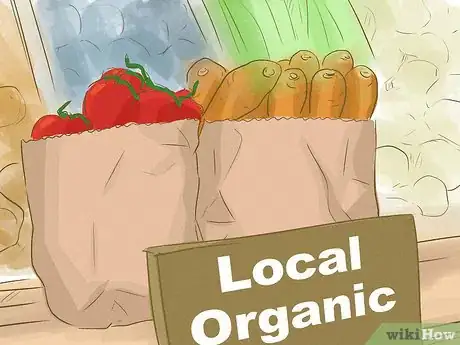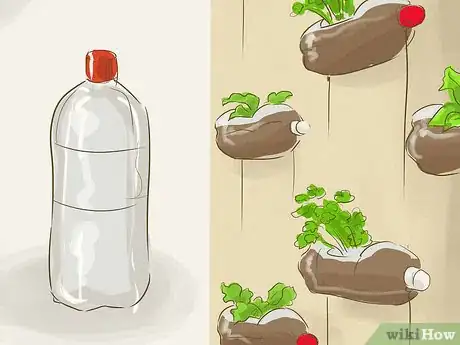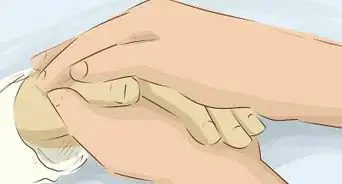This article was co-authored by Chad Herst, CPCC. Chad Herst is the Executive Coach at Herst Wellness, a San Francisco-based wellness center focused on Mind/Body Coaching. Chad is an accredited Co-Active Professional Coach (CPCC) and he has been working in the wellness space for over 19 years, with experience as a yoga teacher, acupuncturist, and herbalist. He received his BA from Columbia University and his MS in Traditional Chinese Medicine from the Pacific College of Oriental Medicine.
There are 13 references cited in this article, which can be found at the bottom of the page.
This article has been viewed 43,412 times.
"Sustainable happiness" is about recognizing that your happiness is interconnected with other people and the natural environment. This idea promotes that our happiness comes from our satisfaction in helping others, forming healthy relationships, and protecting the environment instead of momentary material pleasures. Our daily actions and choices can contribute to our own well-being and that of others. However, our choices can also detract from our well-being, the well-being of other people, or the natural environment. Sustainable happiness can lead you to a healthy, sustainable lifestyle and greater life satisfaction.
Steps
Discovering a Happy Outlook
-
1Make your happy list. Write down all the things that make you happy, including people, places, nature, pets, accomplishments, work, and physical activities. Write freely without censoring yourself. Once you are finished, take a look at your list, and ask yourself if you are embracing these parts of your life. Perhaps there is something you enjoy that you could do more often. Perhaps there is a relationship that is important to you that you have been neglecting.[1]
-
2Consider how your favorite activities might make others less happy. Take another look at your happy list. Ask yourself if there is anything on the list that makes you happy but is not contributing to your well-being. Is it potentially harmful to other people or the environment? Is there anything on your list that you might want to change so that you are contributing to sustainable happiness?
- For example, think about your morning coffee. If it is fair trade coffee, then you know that workers were paid fairly and the coffee was grown with care for the environment. If it is not, it may have been produced by exploitative work practices. Is the habit really good for you? Is it good for the world?[2]
Advertisement -
3Chart your happiness footprint for a week. Draw a table with five columns. In the first column, write down an activity you enjoy. For each activity, fill the other four columns with how it makes you feel, how it affects you, how it affects other people, and how it affects the natural environment. The chart helps you to identify opportunities in your daily life where you can make a shift towards sustainability.[3]
- You may discover that you could reduce waste and improve your health by eating less junk food. This is better for yourself and the environment.
- By walking instead of driving for short trips, you could become more physically active and reduce pollution from car travel.
-
4Treat trauma and underlying medical issues. Sustainable happiness seeks to remove sources of debilitating trauma, such as war, violence, and abuse.[4] If you have experienced trauma in your life — whether you are a war veteran, were in an accident, witnessed a natural disaster, or suffered physical, sexual, or emotional abuse — it is important to work on healing from these experiences.[5] Dealing with trauma is not something that a person should attempt on his own — it is necessary to seek professional help to treat trauma. Look for a therapist who has experience in treating trauma. It's okay to try several different therapists until you find one you like.[6]
- In addition, if you may be suffering from depression, anxiety, or other mental health condition, consider speaking with a counselor who can help you develop the skills you need to manage your emotions and stress.
EXPERT TIPChad Herst is the Executive Coach at Herst Wellness, a San Francisco-based wellness center focused on Mind/Body Coaching. Chad is an accredited Co-Active Professional Coach (CPCC) and he has been working in the wellness space for over 19 years, with experience as a yoga teacher, acupuncturist, and herbalist. He received his BA from Columbia University and his MS in Traditional Chinese Medicine from the Pacific College of Oriental Medicine.Mindfulness Coach
 Chad Herst, CPCC
Chad Herst, CPCC
Mindfulness CoachFace negative emotions head-on. Chad Herst, a career and life coach, says: "Becoming happy takes some work at first that seems counter-intuitive. You have to learn to work with your anxiety, frustration, anger, and other difficult emotions. When we start to develop an ability to face those things without being completely overwhelmed, that capacity will lead to happiness."
-
5Practice mindfulness meditation to increase life satisfaction. Sit cross-legged on the ground or on a cushion. Keep your back straight with your hips above your knees. Either close your eyes or fix your gaze on a nearby point. Think about nothing but your breathing. If your attention is wandering, bring your thoughts back to your breathing.[7] In sustainable happiness, mindfulness is what gives you the ability to appreciate your experiences in the present moment. Mindfulness meditation can help increase your mindfulness throughout the day.
- Start with ten minutes a day. As you get better, you can start working your way up to thirty or forty minutes.
-
6Keep a gratitude journal. Reflecting on your gratitude and appreciation can increase your optimism and overall happiness.[8] You can start by waking up each day and reflecting for a few moments about what you appreciate. Choose one thing every day to appreciate. Write these down in a journal. Some things you can appreciate:
- Do you have a good home?
- Do you have a family whom you love? Friends? Pets?
- Do you enjoy your job?
- What successes have you had recently in life?
-
7Make a sustainable happiness commitment. Commit to at least one thing that you could shift in your life that will enhance your well-being, the well-being of other people, or the well-being of the natural environment. Practice this new commitment every day until it becomes a habit.
- You may give up bottled water and soda to reduce plastic waste.
- You might want to start cooking your own meals so that you know where your food has come from.
- You could start a garden to grow your own food, herbs, or flowers.
- Once this new commitment has become part of your life, you may want to make another commitment.
-
8Do things that support your own well-being. While sustainable happiness is all about creating long-lasting wellness and happiness for your community and yourself,[9] it is important to remember that there will still be highs and lows in life and you will need to know how to support yourself during those low moments. Turning to your community for support is one way to do this. Seeking help from a therapist is another way to support yourself and your long-term happiness and health.
- Try to have realistic expectations about happiness — it's perfectly understandable if you are not happy some of the time; however, you may experience a lot less angst over feeling the range of human emotion if you keep in mind that even darker feelings will pass.
- Learn to address negative thoughts and work on positive thinking. Dealing with feelings of anger, resentment, and stress in healthy ways can help support your well-being and, in turn, help you support those around you.
Creating a Happy and Sustainable Community
-
1Assist others in need. Kindness and altruism are important foundations for happiness. People who report helping others also report higher levels of happiness.[10] If you see someone struggling, offer her help. There are many ways that you can assist others:[11]
- Help someone who has fallen or is injured.
- Take care of a sick family member.
- Donate to charities.
- Comfort a friend going through a death in the family.
-
2Strengthen your support network through meaningful and fun gatherings. Part of the philosophy of sustainable happiness is to create long-lasting connections with people so we are supported through good times and bad.[12] Strengthen your support network by creating frugal and eco-friendly gatherings. These gatherings will promote healthy group activities which will strengthen your bond with each other while promoting sustainable happiness within your social network.[13] You could:
- Throw a potluck dinner where everyone brings a dish.
- Go on a group hike together.
- Start a drive for a local food bank with your friends.
- Rent a plot in a community garden, for which you and your friends share responsibility.
-
3Volunteer for a local charity or cause. Volunteering is a great way to help your community. You will also meet like-minded people and form meaningful relationships. Contact a local organization that supports causes you are passionate about. Ask them if they need any extra help. You could:
- Walk dogs at a local shelter.
- Tutor disadvantaged students who are struggling in school.
- Collect books to donate to a school or library.
-
4Participate in local politics to promote sustainable happiness policies. Sustainable happiness requires political activism to ensure that equitable policies are passed. Not only does political activism increase happiness, but it can help bridge the gap between your individual efforts and the sustainable happiness of the community.[14] [15] Stay alert to how your city council or town hall is dealing with sustainable issues. Read their website for information on upcoming meetings, decisions, and votes. You can:
- Visit an open town hall meeting.
- Organize a peaceful rally.
- Offer to visit schools as an educational speaker.
- Write a letter to your city council members.
Practicing Sustainable Habits for Happiness
-
1Boost your mood by walking instead of driving. In addition to the enjoyment you'll get from walking, you will also be helping the environment. Driving uses gasoline and contributes to pollution. While sometimes driving is inevitable, you can reduce your environmental impact by walking or biking whenever possible. Through healthy exercise, you will improve your health, which will also contribute to your happiness.[16]
- Exercise is an important part of self-care. It releases feel-good hormones known as endorphins, which can boost your mood. Walking briskly for about 35 minutes five days a week, or for an hour three days a week, can be effective in treating mild to moderate depression.[17]
- In addition, exercise can lower blood pressure; reduce risk of heart disease, stroke, and cancer; and improve self-esteem.[18]
-
2Enjoy locally-grown, seasonal foods. Food is often transported long distances, and companies will spend energy on freezing and preserving foods to keep it fresh. By supporting local farmers, you reduce the gas and energy needed to transport the food, and you can ensure that your food is as fresh as possible.[19]
- Go to your local farmer's market for locally grown produce.
- Join a grocery co-op. For a small fee, you will have access to fresh local produce.
- Look for signs in the grocery store that indicate local products.
-
3Reuse household items. Some waste is inevitable, but you can find new uses for old products. Do not throw anything away until it has been fully used. Find new uses for disposable items to reduce waste and consumption. You will also save money, which you can use towards activities that make you happy.
- Cut up old T-shirts to use as rags around the house.
- Save packing materials when you order items. You can use these next time you need to move or ship an item. It saves you from buying new plastic bubble wrap or Styrofoam.
- Clean empty jam jars to store other food. You can also use jars as a drinking glass, as a pot to grow herbs, or as a coin jar.
-
4Fix old electronics instead of buying new. If something breaks in your house, resist the urge to replace it. It is often cheaper to have it fixed instead. Locate a local repairman. This will reduce the waste of a new product, and it will keep your goods working for a long time. You will save money and increase the satisfaction you receive from your eco-friendly electronics.[20]
-
5Organize your house to create a more joyful atmosphere. Material goods do not provide happiness. You may have accumulated many objects over your life that clutter your house. These can foster a disorganized mindset. Go through all of your belongings. Hold each object in your hand. Decide if it makes you happy or not. If you don't need the item and it does not make you happy, put it in a pile. Donate this pile to a charity or thrift-store.
Warning
- Be aware of advertising that tries to tell you that material goods provide happiness.[21]
References
- ↑ http://blog.aha.io/you-will-never-find-worklife-balance/
- ↑ http://hcs.pitt.edu/ojs/index.php/hcs/article/view/122/176
- ↑ http://files.eric.ed.gov/fulltext/EJ1057939.pdf
- ↑ http://greatergood.berkeley.edu/article/item/where_can_we_find_sustainable_happiness
- ↑ http://www.nicabm.com/programs/trauma/
- ↑ http://www.helpguide.org/articles/ptsd-trauma/emotional-and-psychological-trauma.htm
- ↑ https://www.psychologytoday.com/blog/the-courage-be-present/201001/how-practice-mindfulness-meditation
- ↑ http://psycnet.apa.org/psycinfo/2009-05143-063
- ↑ http://greatergood.berkeley.edu/article/item/where_can_we_find_sustainable_happiness
- ↑ http://psycnet.apa.org/psycinfo/2009-05143-063
- ↑ http://www.humanecologyreview.org/pastissues/her182/corral-verdugo.pdf
- ↑ http://greatergood.berkeley.edu/article/item/where_can_we_find_sustainable_happiness
- ↑ http://files.eric.ed.gov/fulltext/EJ1057939.pdf
- ↑ http://sustainablehappiness.ca/wp-content/uploads/2013/01/OBrien_SustainableHappiness_Psychology.pdf
- ↑ http://files.eric.ed.gov/fulltext/EJ1057939.pdf
- ↑ http://hcs.pitt.edu/ojs/index.php/hcs/article/view/122/176
- ↑ http://www.health.harvard.edu/mind-and-mood/exercise-and-depression-report-excerpt
- ↑ http://www.health.harvard.edu/mind-and-mood/exercise-and-depression-report-excerpt
- ↑ http://www.humanecologyreview.org/pastissues/her182/corral-verdugo.pdf
- ↑ http://www.humanecologyreview.org/pastissues/her182/corral-verdugo.pdf
- ↑ http://files.eric.ed.gov/fulltext/EJ1057939.pdf











-Step-6.webp)
































































